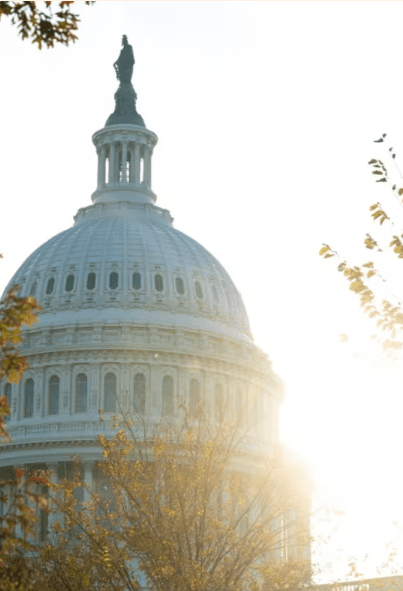WASHINGTON, Nov 10, 2025 — The U.S. Senate took a crucial first step toward ending the longest government shutdown in American history on Sunday, with a bipartisan vote advancing a compromise plan to reopen federal agencies.
The procedural vote passed 60-40, with eight Democrats and one independent joining most Republicans to move the measure forward. The agreement, negotiated behind closed doors by lawmakers from both parties and the White House, would fund the government through the end of January 2026.

The proposed deal also includes provisions to:
- Reverse layoffs imposed during the shutdown.
- Guarantee back pay for furloughed federal workers.
- Offer Democrats a pathway to a future vote on healthcare tax credits, a key sticking point in the standoff.
Next Steps:
After the Senate procedural vote, the measure must still clear a full Senate vote and be approved by the Republican-controlled House before the shutdown officially ends. President Donald Trump expressed optimism, saying late Sunday, “It looks like we are getting close to the shutdown ending. You’ll know very soon.”
Political Divisions:
While some moderate Democrats supported the compromise as a way to protect federal employees and maintain government operations, senior Democrats including Senate Minority Leader Chuck Schumer and House Minority Leader Hakeem Jeffries opposed the deal, criticizing concessions on healthcare tax credits.
Economic Impact:
The shutdown, which began on October 1, has disrupted federal services and delayed welfare benefits, including Supplemental Nutrition Assistance Program (SNAP) payments for over 40 million Americans. Travel disruptions also escalated as the Federal Aviation Administration ordered airlines to reduce flights, with more than 2,700 cancellations reported on Sunday.
Economists warned of potential negative effects on U.S. economic growth if the shutdown continued, while markets showed cautious optimism following the Senate vote. U.S. futures for the S&P 500 and Nasdaq 100 rose 0.7% and 1.2%, respectively, while 10-year Treasury yields ticked up to 4.14%.
Background:
The government shutdown resulted from Congress failing to agree on funding for the new fiscal year. The Senate’s move on Sunday marks the first major bipartisan effort to restore operations and provide relief to federal workers and Americans relying on government services.
If you or your family rely on federal services, especially SNAP benefits or other government programs, it’s important to stay informed during the shutdown and the reopening process:
- Check official sources: Keep an eye on updates from federal agencies, including the USDA for SNAP benefits and the Federal Aviation Administration for travel notices.
- Plan ahead: Expect delays in payments, services, or travel until the government fully reopens.
- Document your situation: If you’re a federal employee, track any furloughs or lost hours, as back pay is expected once the shutdown ends.
- Stay patient and prepared: Be ready for temporary disruptions, but know that Congress and the White House are taking steps to restore services and provide relief.
By staying informed and proactive, you can reduce stress and manage disruptions caused by government shutdowns.